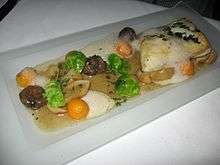Beurre noisette
 Pan roasted halibut and vegetables sauced with beurre noisette sauce at the bottom of the dish | |
| Type | Sauce |
|---|---|
| Place of origin | France |
| Main ingredients | Butter |
Beurre noisette (French pronunciation: [bœʁ nwazɛt], literally: hazelnut butter, loosely: brown butter)[1] is a type of warm sauce used in French cuisine. It can accompany savoury foods, such as winter vegetables,[2] pasta,[3] fish, omelettes,[4] and chicken.[5] It is also used in making French pastry. It is notable for its deep yellow, almost brown colour, and nutty scent and flavour from the heating process.
Preparation
Unsalted butter is melted over low heat and allowed to separate into butterfat and milk solids. The latter naturally sink to the bottom of the pan and, if left over gentle heat, will begin to brown. As they reach a toasty hazelnut colour, the pan is removed from the heat.
Beurre noisette may be used in its liquid state or cooled to a solid form. It has a nutty flavour and is particularly included in the batters for madeleines and financiers.
If beurre noisette is not mixed after preparation but separated into the firm (protein) and liquid (fat) components, the latter is the type of clarified butter known as ghee in South Asia and samna in the Middle East countries.
See also
- Beurre noir, "black butter", a similar sauce cooked for longer
- Niter kibbeh, a type of clarified butter cooked with spices in Ethiopian cuisine
- Schmaltz, clarified animal fat
References
- ↑ Julia Child, Louisette Bertholle & Simone Beck (2001). Mastering the Art of French Cooking, Vol. 1. Alfred A. Knopf. pp. 98–99. ISBN 0-375-41340-5.
- ↑ The Cookbook Critic: Off the Shelf: Pasta with Pumpkin and Sage Brown Butter.
- ↑ goat's cheese ravioli with walnut beurre noisette Archived August 29, 2008, at the Wayback Machine..
- ↑ "Smoked trout and chive souffle omelette with lemon beurre noisette". Gourmet Traveller. Retrieved 19 November 2015.
- ↑ Salt crust chicken With bread sauce and beurre noisette Archived May 5, 2009, at the Wayback Machine..